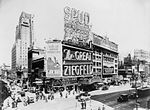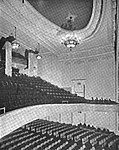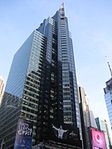Gaiety Theatre (New York City)
1909 establishments in New York City1982 disestablishments in New York (state)Buildings and structures demolished in 1982Demolished buildings and structures in ManhattanFormer Broadway theatres ... and 5 more
Manhattan building and structure stubsTheater District, ManhattanTimes Square buildingsUnited States theater (structure) stubsUse mdy dates from October 2020
The Gaiety Theatre was a Broadway theatre at 1547 Broadway in Times Square, Manhattan, New York City from 1909 until 1982, when it was torn down. The office building that housed the theatre, the Gaiety Building, has been called the Black Tin Pan Alley for the number of African-American songwriters, who rented office space there. It was designed by Herts & Tallant and owned by George M. Cohan. The theatre introduced revolutionary concepts of a sunken orchestra (the previous configuration had the orchestra on the same level as the seats in front of the stage) and also not having pillars obstructing sight lines for the balcony.
Excerpt from the Wikipedia article Gaiety Theatre (New York City) (License: CC BY-SA 3.0, Authors).Gaiety Theatre (New York City)
Broadway, New York Manhattan
Geographical coordinates (GPS) Address Website Nearby Places Show on map
Geographical coordinates (GPS)
| Latitude | Longitude |
|---|---|
| N 40.758544 ° | E -73.985406 ° |
Address
New York Marriott Marquis (Marriott Marquis)
Broadway 1535
10019 New York, Manhattan
New York, United States
Open on Google Maps











